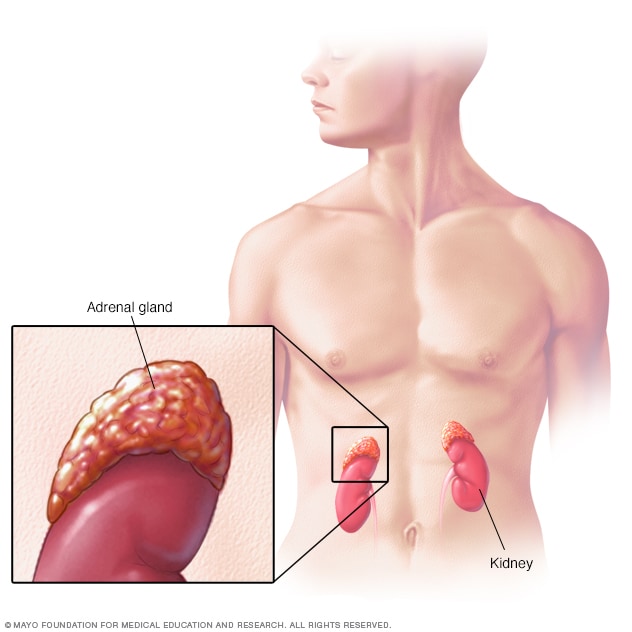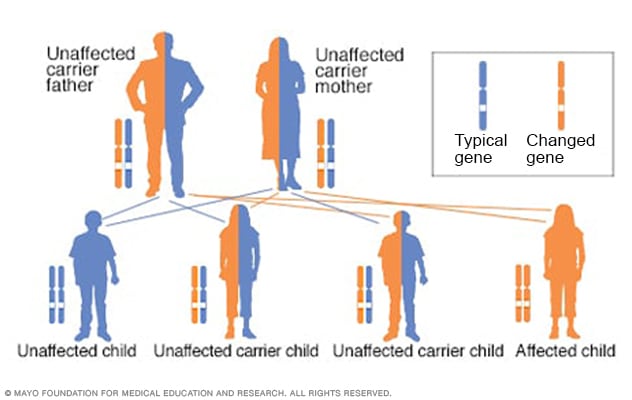Overview
Adrenal glands

Adrenal glands
Located on top of the kidneys, the adrenal glands make hormones that help regulate metabolism, the immune system, blood pressure and other important functions. Although small, these glands control much of what happens in the body.
Congenital adrenal hyperplasia (CAH) is the medical name for a group of genetic conditions that affect the adrenal glands. The adrenal glands are a pair of walnut-sized organs above the kidneys. They make important hormones, including:
- Cortisol. This controls the body's response to illness or stress.
- Mineralocorticoids such as aldosterone. These control sodium and potassium levels.
- Androgens such as testosterone. These sex hormones are needed for growth and development in both males and females.
In people with CAH, a gene change results in a lack of one of the enzyme proteins needed to make these hormones.
The two major types of congenital adrenal hyperplasia are:
- Classic CAH. This type is rarer and more serious. It's usually found by tests at birth or in early infancy.
- Nonclassic CAH. This type is milder and more common. It may not be found until childhood or early adulthood.
There is no cure for congenital adrenal hyperplasia. But with proper treatment, most people who have CAH can lead full lives.
Products & Services
Symptoms
Symptoms of CAH vary. The symptoms depend on which gene is affected. They also depend on how greatly the adrenal glands lack one of the enzymes needed to make hormones. With CAH, the hormones that the body needs to work properly are thrown out of balance. That may lead to too little cortisol, too little aldosterone, too many androgens or a mix of these issues.
Classic CAH
Symptoms of classic CAH can include:
- Not enough cortisol. With classic CAH, the body doesn't make enough of the hormone cortisol. This can cause problems keeping blood pressure, blood sugar and energy at healthy levels. It also can cause problems during physical stress such as illness.
- Adrenal crisis. People with classic CAH can be seriously affected by a lack of cortisol, aldosterone or both. This is known as an adrenal crisis. It can be life-threatening.
-
External genitals that don't look typical. In female infants, some parts of the genitals on the outside of the body may look different than usual. For instance, the clitoris may be enlarged and resemble a penis. The labia may be partly closed and look like a scrotum. The tube through which urine leaves the body and the vagina may be one opening instead of two separate openings. The uterus, fallopian tubes and ovaries often develop in a typical manner.
Male infants with CAH often have genitals that look typical but sometimes are enlarged.
-
Too much androgen. An excess of the male sex hormone androgen can lead to short height and early puberty for children. Pubic hair and other signs of puberty may appear at a very early age. Serious acne also may occur.
Extra androgen hormones in females may lead to facial hair, more body hair than usual and a deeper voice.
- Altered growth. Children may grow fast. And their bones could be more developed than is typical for their age. Final height may be shorter than average.
- Fertility issues. These can include irregular menstrual periods or not having periods at all. Some women with classic CAH may have trouble becoming pregnant. Fertility issues sometimes can occur in men.
Nonclassic CAH
Often, there are no symptoms of nonclassic CAH when a baby is born. Some people with nonclassic CAH never have symptoms. The condition is not found on routine infant blood screening tests. If symptoms occur, they usually appear in late childhood or early adulthood.
Females who have nonclassic CAH may have genitals that look typical at birth. Later in life, they may have:
- Irregular menstrual periods, or none at all.
- Trouble getting pregnant.
- Features such as facial hair, more body hair than usual and a deeper voice.
Sometimes, nonclassic CAH may be confused with a hormonal condition that happens during the reproductive years called polycystic ovary syndrome.
Nonclassic CAH symptoms in children of either birth sex also can include:
- Symptoms of early puberty, such as growth of pubic hair sooner than usual.
- Serious acne.
- Rapid growth during childhood with bones that are more developed than is typical.
- Shorter than expected final height.
When to see a doctor
Most often, classic CAH is found at birth through routine newborn screening tests. Or it's found when a baby's outer genitals do not look typical. CAH also may be detected when infants show symptoms of serious illness due to low levels of cortisol, aldosterone or both.
In children who have nonclassic CAH, symptoms of early puberty may appear. If you have concerns about your child's growth or development, schedule a checkup with your child's healthcare professional.
In older people who have irregular periods, trouble getting pregnant or both, screening for CAH may be appropriate.
If you are planning pregnancy or are pregnant and may be at risk of CAH, ask your healthcare professional about genetic counseling. A genetic counselor can tell you if your genes might affect you or any children you decide to have.
Causes
Autosomal recessive inheritance pattern

Autosomal recessive inheritance pattern
To have an autosomal recessive disorder, you inherit two changed genes, sometimes called mutations. You get one from each parent. Their health is rarely affected because they have only one changed gene. Two carriers have a 25% chance of having an unaffected child with two unaffected genes. They have a 50% chance of having an unaffected child who also is a carrier. They have a 25% chance of having an affected child with two changed genes.
The most common cause of CAH is the lack of the enzyme protein known as 21-hydroxylase. Sometimes, CAH is called 21-hydroxylase deficiency. The body needs this enzyme to make proper amounts of hormones. Very rarely, a lack of other much rarer enzymes also can cause CAH.
CAH is a genetic condition. That means it's passed from parents to children. It's present at birth. Children with the condition have two parents who both carry the genetic change that causes CAH. Or they have two parents who have CAH themselves. This is known as the autosomal recessive inheritance pattern.
People can carry the CAH gene and not have symptoms of the condition. This is called being a silent carrier. If a silent carrier becomes pregnant, that person can pass the gene to a child. If tests show that you're a silent carrier of the CAH gene and you have a partner of the opposite sex, talk with your healthcare professional. It's likely that your partner will need to get tested for the CAH gene before pregnancy so that you can better understand the risks.
Risk factors
Factors that raise the risk of having CAH include:
- Parents who both have CAH.
- Parents who are both carriers of the changed gene that causes CAH.
- Being of Ashkenazi Jewish, Latino, Mediterranean, Yugoslav or Yup'ik descent.
Complications
People who have classic CAH are at risk of a life-threatening condition called adrenal crisis. This emergency needs to be treated right away. Adrenal crisis can happen within the first few days after birth. It also can be triggered at any age by an infectious illness or physical stress such as surgery.
With adrenal crisis, very low levels of cortisol in the blood can cause:
- Diarrhea.
- Vomiting.
- Dehydration.
- Confusion.
- Low blood sugar levels.
- Seizures.
- Shock.
- Coma.
Aldosterone also may be low. This leads to dehydration, low sodium and high potassium levels. The nonclassic form of CAH doesn't cause adrenal crisis.
People who have either classic or nonclassic CAH may have irregular menstrual cycles and fertility issues.
Prevention
There is no known way to prevent CAH. If you're thinking of starting a family and you're at risk of having a child with CAH, talk with your healthcare professional. You may be told to see a genetic counselor.